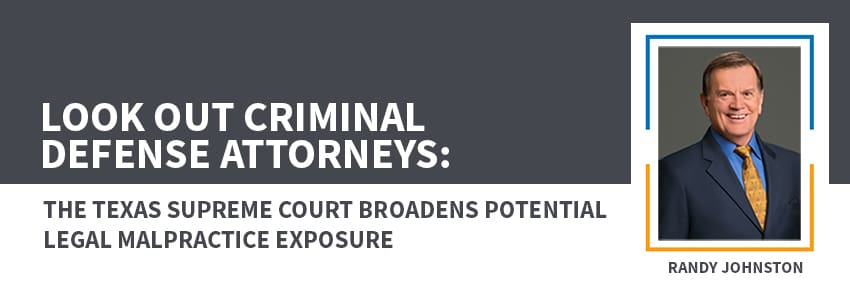 After the Texas Supreme Court’s decision in Peeler v. Hughes & Luce, Texas criminal defense lawyers generally felt that they had immunity from malpractice claims. In that case, after being convicted and sentenced, Ms. Peeler sued her criminal defense counsel for malpractice because he had failed to communicate a plea-bargain to her under which she was offered immunity and no jail time. The Court dismissed her claims, ruling that a criminal defendant cannot sue for malpractice with establishing actual innocence through direct appeal or post-conviction habeas corpus relief.
After the Texas Supreme Court’s decision in Peeler v. Hughes & Luce, Texas criminal defense lawyers generally felt that they had immunity from malpractice claims. In that case, after being convicted and sentenced, Ms. Peeler sued her criminal defense counsel for malpractice because he had failed to communicate a plea-bargain to her under which she was offered immunity and no jail time. The Court dismissed her claims, ruling that a criminal defendant cannot sue for malpractice with establishing actual innocence through direct appeal or post-conviction habeas corpus relief.
In its recent decision in Gray v. Skelton, the Court modified its holding in Peeler and its prior holding in Hughes v. Mahoney & Higgins, which tolls limitations on legal malpractice claims during appeals on the underlying case. Both modifications make it easier to prosecute legal malpractice claims against criminal defense attorneys.
Ms. Skelton, herself an attorney, was convicted of forging a will. Her side of the story is pretty compelling. She appealed alleging, among other things, that her trial counsel rendered ineffective assistance in violation of the Sixth Amendment. The court of appeals upheld her conviction and the court of criminal appeals refused discretionary review. Ms. Skelton then filed a habeas petition alleging ineffective assistance and, eventually, the court of appeals vacated her conviction. The state then dismissed the charges without a second trial. And Ms. Skelton sued her original attorney for malpractice.
The first issue presented by these facts is how a criminal defendant establishes the “actual innocence” requirement of Peeler. Ms. Skelton argued that having her conviction vacated and all charges dismissed was enough, particularly when she is entitled to a presumption of innocence. Her former lawyer sought dismissal because her habeas petition established his ineffective assistance but not her innocence.
The Court rejected Ms. Skelton’s “presumption of innocence” argument, observing that the presumption is merely a burden-of-proof rule. Ms. Skelton could be guilty of the crime even if she had been acquitted. Had the Court stopped there, the only criminal defendants who would be allowed to pursue a malpractice claim would be ones who secured a finding of actual innocence in a post-conviction proceeding.
But rather than denying the right to pursue a malpractice claim to all such criminal defendants, the Court adopted a modified procedure and a change to the law of professional negligence. For a criminal defendant pursuing a legal malpractice claim, the Court added to the four elements of the cause of action (duty, breach, proximate cause, and damages) a fifth requirement. The plaintiff must obtain a jury finding of actual innocence as a predicate to submission of the legal malpractice claim. The first question the jury will be asked is whether the plaintiff was innocent of the charge. Only upon an affirmative answer to that question, would the traditional legal malpractice jury issues would be submitted. The plaintiff’s burden of proof on the innocence question is the same as on all other questions: a preponderance of the evidence.
The second issue the Court decided deals with the calculation of limitations for a criminal defendant’s legal malpractice claim. The Hughes rule tolls limitations during direct appeals for the criminal defendant the same way it tolls limitations for the civil litigant. The ineffective lawyer representing Ms. Skelton argued, however, that the Hughes tolling rule should not apply to post-conviction proceedings because (1) they often are not initiated until years after the conviction and (2) there can be multiple habeas proceedings in succession.
To solve this problem, the Court extended the Hughes tolling rule to toll limitations for a criminal defendant for the entire time a habeas corpus proceeding is pending, but not during any gaps between direct appeals and habeas corpus. Thus, a criminal defendant who initiates a habeas corpus proceeding less than two years after the conclusion of all direct appeals would still have the opportunity to pursue a legal malpractice claim if the habeas proceeding is successful.
The first and most obvious lesson for the criminal defense lawyer from the Skelton case is that they may now be sued for malpractice if they provide ineffective assistance to a criminal defendant client. Insurance may be in order. A second, but related, lesson is that criminal defense attorneys should keep track of their clients post-conviction and track their appeals and habeas proceedings before they discard files. Getting sued without the file can not only deprive you of the ability to defend yourself, it can also result in a spoliation instruction for destroying evidence.
